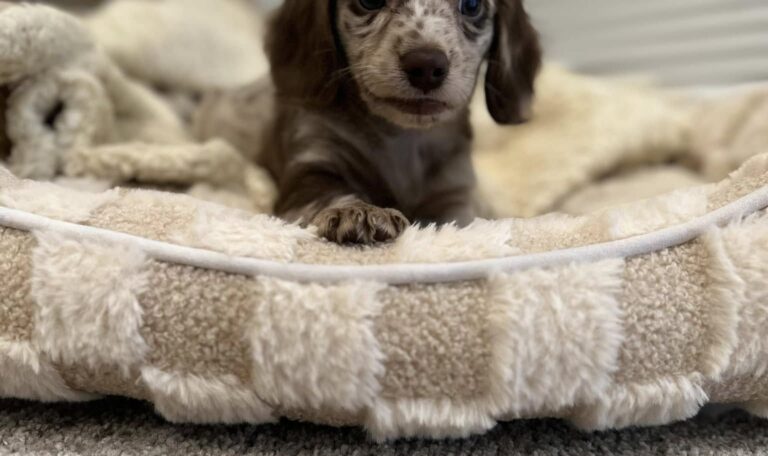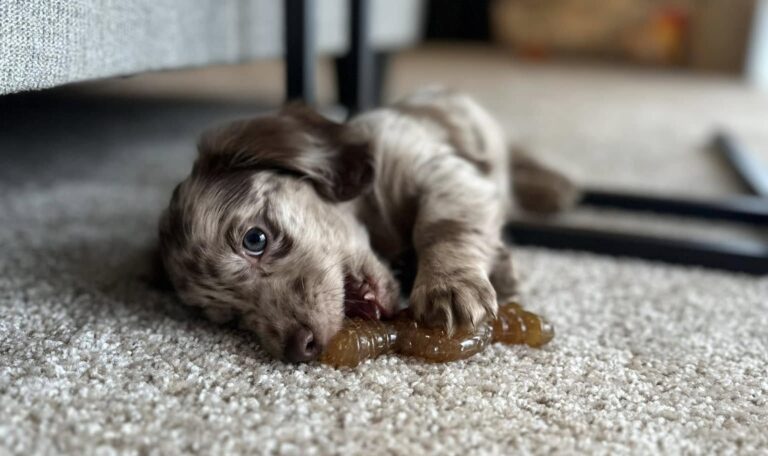How To Crate Train a Dachshund Puppy
How To Crate Train a Dachshund Puppy
How To Crate Train a Dachshund Puppy! Have you recently welcomed a dachshund puppy into your home? Are you considering crate training but unsure where to begin? Or perhaps you’ve already purchased a crate and need guidance on how to use it effectively. If you’re seeking answers on how to properly crate train your dachshund puppy, this guide is here to help.
How to Crate Train a Dachshund Puppy
Choose an appropriately sized crate
Position the crate in your bedroom
Add a soft, comfortable cushion as a base
Drape a blanket over the top and three sides to create a den-like atmosphere
Place an item with your scent inside for comfort
Always remove your puppy’s collar before crating
Use treats to encourage your dachshund to enter the crate voluntarily
Begin with short periods of crating and gradually increase duration
Avoid placing food or water in the crate overnight
Ensure your puppy relieves itself before bedtime
Use calm, soothing words to help settle your puppy at night
Never leave your dachshund crated for extended periods
In this article, you’ll learn why crate training can be beneficial, how to choose the right size crate, how to set it up, what to include inside, how to introduce your puppy to it, how to handle whining or crying, and what to expect during the first few nights.

Table of Contents
Why use a crate for your dachshund puppy?
Should you buy a wire or plastic dog crate for a dachshund puppy?
What is the best crate size for a dachshund puppy?
How do you set up a crate for a dachshund puppy?
Where do you set up a crate for a dachshund puppy?
Should I put food in the crate with my dachshund puppy?
Should I put water in the crate with my dachshund puppy?
Should you put dog toys in a dachshund’s crate?
Do you remove a dachshund’s collar when in the crate?
How do you introduce a dachshund puppy to a crate
How do you use a crate in the day?
How do you use a crate in the evening?
What should you expect for the first few nights of crate training?
What do you do if your dachshund puppy cries in the crate?
What do you do if your dachshund puppy pees in the crate?
How long can you leave a dachshund in a crate?
Is crate training a dachshund cruel?
Is it hard to crate train a dachshund puppy?
Can you crate train an older dachshund?
How much is a dog crate for a dachshund?
How long does it take to crate train a dachshund puppy?
What is the next step?
What do I do next?
Note: Research and my own experience as a Dachshund owner of over ten years served as the foundation for this post. I’m not a certified dog behaviorist or veterinarian.
Crates are highly effective tools for potty training, offering a structured and manageable approach for new puppy owners. Their success lies in a dog’s natural instinct to keep their sleeping area clean. Dachshunds, like most dogs, are generally reluctant to eliminate where they eat and sleep, making the crate a useful aid in establishing good bathroom habits.

1. Crates Keep Your Dachshund Safe and Secure
Crates provide a safe and secure environment for your dachshund, especially overnight or when you’re unable to supervise directly. Whether you’re stepping out of the room to use the bathroom or answering the door, a crate ensures your puppy is contained and out of harm’s way. Allowing a dachshund to roam freely when unattended can lead to destructive behaviors such as chewing electrical cords or damaging furniture—common mischief for curious pups left unsupervised.
While alternatives like playpens or baby gates can help limit your dachshund’s access to certain areas, they’re not as effective for potty training. These larger spaces don’t activate a dog’s natural instinct to keep their sleeping area clean. In a larger area, your dachshund may eliminate at one end and play at the other, which undermines the effectiveness of house training. While confined spaces are still useful for daytime supervision, crates remain the best choice for nighttime or when you need to leave the room.
2. Crates Are Practical When Traveling
Crates are incredibly convenient for travel. Bringing your dachshund’s crate along when visiting friends, staying in hotels, or going on holiday gives your dog a familiar and comforting place to sleep. Much like humans prefer their own beds, dogs feel more relaxed and secure in familiar surroundings—especially in new or unfamiliar environments.
3. Crates Are Valuable for Vet Visits and Emergencies
Crate training can also be beneficial in medical situations. Dachshunds are particularly prone to Intervertebral Disc Disease (IVDD), with approximately 1 in 4 affected. If your dachshund experiences an episode, the first stage of treatment often involves strict crate rest. A dog that is already crate trained will likely handle this period with less stress and anxiety.
Additionally, if your dog ever needs to stay at the vet’s office in a crate or kennel, being accustomed to a crate environment can help ease the experience and reduce distress.
4. Crates Provide a Designated Rest Area
In busy households—especially those with young children—a crate can serve as a quiet, safe space for your dachshund to rest and recharge. Puppies require plenty of sleep and should not be overstimulated or overexercised. Establishing a household rule that the crate is a no-interruption zone when the puppy is sleeping can help everyone respect your dog’s need for downtime.

Crates Provide a Cozy, Secure Den
Dachshunds can be sensitive dogs, and some are prone to anxiety—particularly in unfamiliar or overstimulating environments. A well-designed crate serves as a comfortable and secure den where your dachshund can retreat when feeling overwhelmed. Whether you’re hosting guests, there’s a lot of noise in the home, or your dog simply needs a quiet space to relax, the crate offers a safe haven where he can feel calm and undisturbed.
Crates Encourage Independence
As a breed, dachshunds are known for their deep loyalty and strong bond with their owners. While this affectionate nature is part of their charm, it can sometimes lead to separation anxiety. Crate training helps your dachshund develop a sense of independence by providing a dedicated, calming space he can call his own. It reinforces the idea that he doesn’t need to be by your side at all times to feel secure, and this often results in a more well-adjusted and confident dog.
Long-Term Use of Crates
Crates are a practical training tool during puppyhood, particularly for house training and establishing routines. As your dachshund matures and becomes fully house trained, the need for crating may decrease. In most cases, adult dachshunds do not require regular crating unless for health-related reasons or specific situations. However, many dogs grow to enjoy their crates and continue to use them as a place to rest or nap. Simply leave the crate door open and allow your dachshund to use it at his discretion—once trained, most dachshunds are perfectly content and trustworthy around the home.
Wire Crates: A Practical and Versatile Option
Wire crates are a practical and durable choice for dachshund owners. They offer excellent ventilation and visibility, allowing your dog to remain aware of their surroundings, which can be particularly reassuring for an alert breed like the dachshund. These crates are also easy to maintain—the removable bottom tray makes cleaning up accidents simple and efficient. Additionally, wire crates fold flat for convenient storage or transport, making them ideal for travel or space-saving at home. When covered with a blanket or a custom-fit fabric cover, the crate transforms into a cozy, den-like space that provides both comfort and security for your dachshund.
Choosing the Right Crate Size for Your Dachshund
Recommended Crate Sizes
As a general guideline, a 24-inch crate is typically suitable for a miniature dachshund, while a 30-inch crate is ideal for a standard dachshund. The crate should be large enough for your dog to stand, sit, lie down, and turn around comfortably. However, it should not be so spacious that your puppy can eliminate at one end and sleep at the other, as this can undermine house training efforts.
Select a Crate Based on Adult Size
When purchasing a crate, choose one that accommodates the size of a fully grown dachshund. If your puppy is still very small, you can place a soft, high-sided dog bed inside to reduce the internal space and create a more secure, comforting environment. Some crates also include adjustable dividers, allowing you to gradually increase the space as your puppy grows.
Adapt the Size to Your Individual Dog
Dachshunds vary in size and proportions, especially if your dog is larger than average or a dachshund mix. Be sure to adjust the recommended crate size accordingly to suit your individual dog’s needs. If your dachshund outgrows the crate, replace it—never confine your dog to a space that is too small or restrictive. Your dachshund should always be able to move freely and feel comfortable inside.
Consider Transport and Vehicle Fit
If you plan to use the crate for car travel, be sure to check the crate’s dimensions against your vehicle’s interior space. Measure the height, width, and depth to ensure a proper fit. In some cases, especially with smaller vehicles, you may need to invest in two crates: a compact one for travel and a larger one for home use.
Begin by creating a warm, inviting space inside the crate. Place a soft cushion or padded base on the floor of the crate and layer it with cozy blankets to ensure comfort. To create a den-like atmosphere, drape a blanket over the back and sides of the crate, leaving the front open so your dachshund can see out and feel secure. Alternatively, consider using a fitted fabric crate cover designed specifically for pet crates to achieve a more tailored look.
If you live in a warmer climate, opt for lightweight, breathable materials rather than thick or heavy blankets to avoid overheating. For convenience, choose items that are machine washable to make regular cleaning quick and hassle-free.

Add a Familiar Scent
To help your dachshund feel secure, place an item inside the crate that carries a familiar scent. A recently worn (but unwashed) t-shirt of yours can provide comfort, as can a blanket or toy from the breeder that still carries the scent of the puppy’s mother or littermates. These familiar smells can ease nighttime anxiety and encourage restful sleep.
Important Safety Note
Keep in mind that puppies are prone to chewing. Avoid leaving your dachshund unsupervised in the crate with any items that could be easily torn apart or ingested. Use your judgment to ensure everything placed inside the crate is safe and non-toxic.
Use a Dog Bed for Small Puppies
If the crate feels too large for a young puppy, place a small, supportive dog bed inside—ideally one with soft, rounded sides to create a cozy nest-like feel. As your dachshund grows, you can replace the bed with a soft crate mat or cushion that covers the entire base.
Try a Heartbeat Toy for Comfort
Consider placing a heartbeat toy, such as a “Heartbeat Sheep,” inside the crate. These soft toys contain a small device that emits a gentle pulsing vibration, simulating the heartbeat of the puppy’s mother. This can provide emotional reassurance and help ease separation anxiety. A traditional ticking clock placed near the crate can have a similar calming effect.
Use a Heated Puppy Pad
A microwaveable puppy heat pad can replicate the warmth of the mother and littermates, helping your dachshund feel safe and comforted. Look for models with fleece covers and extended warmth (up to 10 hours), especially useful during the first few nights in a new environment.
Leave a Night Light On
Moving to a new home can be overwhelming for a young puppy. To reduce stress during the night, leave a dim night light or hallway light on so your puppy isn’t left in total darkness. Being able to see their surroundings—or you—can be very reassuring.
Monitor with a Pet Camera
If possible, install a pet camera to check in on your dachshund while you’re away. This can provide peace of mind and allow you to monitor your puppy’s behavior. Devices like the Furbo even let you talk to your dog remotely and dispense treats, which can be especially helpful during early training and bonding.
Where do you set up a crate for a dachshund puppy?
Start with the Crate in Your Bedroom
If space allows, it’s best to position the crate in your bedroom during the first few weeks. This helps your new puppy feel safe and reassured by your presence as they adjust to their new environment. Once your dachshund is more settled, you can gradually move the crate to its permanent location.
Consider Setting Up Two Crates
Although crates are portable, having two separate setups—one for day use and one for nighttime—can be more convenient. Ideally, place the daytime crate in a communal area such as the kitchen or living room, where your puppy can be near the family and feel part of daily life. A crate positioned where people regularly spend time helps reduce feelings of isolation and promotes bonding.
Choose a Safe and Comfortable Location
Be mindful of the crate’s immediate surroundings. Avoid placing it in direct sunlight or in areas that are too cold or drafty. Aim for a stable room temperature and ensure the area around the crate is free of hazards such as electrical cords or small objects your dachshund could pull inside and chew. Creating a calm, secure, and hazard-free environment will help your puppy feel relaxed and safe in their new den.
It’s not recommended to leave food in your dachshund’s crate. Dachshunds are typically enthusiastic eaters and are unlikely to leave food uneaten—it will usually be consumed within moments. Instead, it’s best to establish consistent mealtimes to support healthy digestion and routine.
If you’re away during feeding times, arrange for someone to come in and feed your dachshund. Puppies generally require 3 to 4 meals per day to support their rapid growth and energy needs, while adult dachshunds typically do well on two meals per day.
Structured feeding not only supports your dog’s health but also reinforces positive behavior and helps with training and housebreaking.
Water Access While Crated
If you’re at home and the crate door is open, it’s perfectly fine to place a water bowl just outside the crate. However, if your dachshund is crated for any length of time with the door closed, it’s important to ensure water is accessible. In these cases, use a clip-on water bowl or bottle that securely attaches to the side of the crate—this prevents spills and ensures your dog stays hydrated.
Avoid Extended Crating Without Water
Dogs need regular access to water throughout the day. If your dachshund will be crated for more than a brief period—such as when you’re out of the house or overnight—it’s essential to either provide water or arrange for someone to check in. Puppies, in particular, require frequent potty breaks and should not be left crated for long stretches without access to water or relief.
No Water in the Crate Overnight During Potty Training
When using the crate for house training, it’s best not to leave water in the crate overnight. Dachshund puppies have small bladders and limited control, so limiting water before bedtime can help reduce nighttime accidents and support successful potty training.
Consider Medical Needs
In some cases, your dachshund may require constant access to water. Medical conditions such as diabetes, Cushing’s disease, or the side effects of certain medications can increase thirst. Always consult your veterinarian and adapt your approach based on your dog’s individual health needs.
Yes and no. Toys can be a great source of comfort and mental stimulation for your dachshund, but they also present potential safety risks—particularly when unsupervised. Many plush toys can be quickly destroyed, with stuffing, squeakers, or small parts (like ears or tails) posing choking or ingestion hazards.
If you’re present and able to supervise, soft toys are generally fine. However, if you’re leaving your dachshund alone in the crate, it’s best to opt for a more durable option, such as a KONG or another heavy-duty chew toy designed specifically for safe solo play. While no toy is truly indestructible, these types of toys are typically safer choices for unsupervised periods.
Dachshunds absolutely need toys to stay mentally and physically engaged, but it’s important to use your judgment and consider your dog’s age, chewing habits, and behavior. Safety should always come first—particularly with young puppies.
Yes, for safety reasons, it’s strongly recommended to remove your dachshund’s collar before placing them in the crate. Collars can easily become caught on the crate bars or other parts of the structure, posing a serious risk of injury or strangulation.
Given how simple collars are to remove and put back on, it’s best to err on the side of caution and take them off whenever your dachshund is crated—especially if they will be left unsupervised.
Allow Time for Exploration
Begin by letting your puppy explore the crate at his own pace. On the first day, keep the door open and avoid closing it immediately. A helpful technique is to place your puppy’s food inside the crate while keeping him outside. Wait a few minutes before opening the door—this builds anticipation and helps your puppy associate the crate with positive experiences and rewards.
Create Positive Associations
The goal is to make the crate a welcoming and enjoyable space—not a place of confinement or punishment. Keep the door open during mealtimes initially, and allow your puppy to come and go freely. Use toys and treats to reinforce positive behavior. For example, place a favorite toy or treat inside the crate and wait a few moments before opening the door, turning it into a rewarding game.
Through consistent positive reinforcement, your dachshund will begin to see the crate as a safe, rewarding environment.
Take a Gradual Approach
If your dachshund seems hesitant to enter the crate, introduce it slowly and positively. Start by placing food or treats just outside the entrance, gradually moving them further inside as your puppy gains confidence. You can also hide small treats under blankets inside the crate to encourage natural exploration and sniffing behavior. This gentle approach helps your puppy become more comfortable with the space over time.
Begin Closing the Door Briefly
Once your puppy is entering and exiting the crate freely, you can begin to close the door for short periods. Start with just a couple of minutes, remaining in the room and behaving as you normally would. It’s important to act calm and relaxed—if you appear anxious, your puppy will sense it. Some initial whining or fussing is normal, but avoid reacting emotionally. Quiet consistency helps build trust.
Offer Positive Reinforcement
As your dachshund becomes more comfortable, be sure to offer praise and encouragement each time he voluntarily enters the crate. Reinforcing this behavior with calm, positive reinforcement helps him understand that the crate is a safe, secure place. Over time, this will make settling at night and handling periods of separation much easier.
Supervised Time Outside the Crate
You don’t need to crate your puppy during the day as long as you’re home, attentive, and actively watching for signs that he needs to go to the toilet. The primary purpose of the crate is to prevent accidents when your puppy can’t be supervised and to provide a safe space for rest, particularly overnight.
If you’re home, it’s beneficial to leave the crate door open and allow your dachshund to explore it freely. If he chooses to rest, nap, or play inside, that’s ideal. The more relaxed and comfortable your puppy becomes around the crate, the easier the overall training process will be.
Encourage Rest in the Crate
When your puppy starts to look tired, gently guide him into the crate. If he falls asleep, you can close the door quietly. Once he wakes up, take him straight outside for a toilet break. The goal is to create a positive association where your puppy willingly enters the crate to rest and isn’t concerned when the door is closed.
Using the Crate for Potty Training
The crate can also support house training. Place your puppy in the crate and take him outside for a toilet break every 20 minutes. If he eliminates, praise him warmly and reward with a treat. If he doesn’t, bring him back inside and return him to the crate. Repeat the process every 20 minutes until he begins to understand the routine. Consistency and positive reinforcement are key.
Planning Around Work Commitments
If you work full-time, it’s advisable to take a few weeks off when bringing your puppy home. This time allows you to establish a routine, build trust, and lay the foundations for successful training. If taking time off isn’t possible, arrange for a friend, family member, or pet sitter to visit throughout the day to provide companionship, toilet breaks, and supervision. With a bit of support, you can create a manageable and positive transition for both you and your dachshund.
It’s completely natural to want to cuddle and hold your new puppy, especially during those early days. However, constant physical contact—particularly in the evenings—can unintentionally make crate training more challenging.
If your puppy becomes accustomed to falling asleep on your lap or being held for long periods, transitioning to sleeping alone in the crate may feel unsettling or even distressing. To support successful crate training, it’s important to create a balance: offer plenty of affection during the day, but also encourage your puppy to rest independently in the crate. This helps your puppy develop healthy sleeping habits and builds confidence in being alone.
Cuddle time with your new puppy is one of the most rewarding parts of bringing them home. However, during the early stages of crate training, it’s helpful to be mindful of how and when you offer physical comfort.
Instead of letting your puppy fall asleep in your arms or on your lap, gently place them in their crate when they begin to get sleepy. You don’t need to close the door—simply cover the crate with a light blanket to create a cozy, den-like atmosphere. This teaches your puppy that the crate is their designated sleeping space. By establishing this routine early, the transition to night-time crating becomes much smoother, as the only change will be closing the crate door.
This approach may feel challenging at first, but it’s only temporary. Once your dachshund is reliably crate and potty trained, you can relax the structure and enjoy all the cuddles you like—whether that’s on the sofa or wherever you’re most comfortable.
That said, every owner is different. Some prefer to keep their dachshund close at all times, and that’s perfectly fine too. Crate training can still be successful with this approach, though you may experience a bit more resistance at bedtime if your puppy has spent the evening napping on your lap.
Ultimately, it’s about finding a routine that works for you and your dachshund while still setting the foundation for healthy habits and independence.
It’s completely normal for your dachshund puppy to cry in the crate during the first few nights. This is a new environment, and it will take time for your puppy to feel completely secure.
First, ensure your puppy has had enough toilet breaks before bedtime. If you’re confident he doesn’t need to go out, gently reassure him with a calm, consistent phrase such as “Settle down.” Speak in a soft, soothing voice and repeat the same words each time. When he stops crying, even briefly, calmly say “Good boy” to reinforce the quiet behavior.
It may take several nights for your puppy to fully adjust, but with patience, consistency, and a clear routine, he will begin to feel safe and comfortable sleeping in his crate.
As difficult as it may be, it’s important not to immediately respond to your dachshund’s cries by letting him out of the crate—unless there is a genuine need, such as a toilet break. Reacting too quickly can inadvertently teach your puppy that crying or barking is an effective way to gain attention or be released from the crate.
Instead, wait for a brief moment of silence before opening the crate door. This helps reinforce calm behavior and encourages your puppy to settle independently. When he is quiet, gently praise him and offer reassurance.
That said, if your puppy is crying persistently, he may genuinely need to relieve himself. Young dachshunds have small bladders and often require toilet breaks during the night. If this is the case, take him outside calmly and quietly, avoiding stimulation, and then return him to the crate immediately afterward.
With consistency and patience, your puppy will begin to understand the routine and learn to sleep peacefully through the night.
If your dachshund urinates or defecates in the crate, remain calm and clean it up promptly. Most crates come with a removable base tray that can be taken out and thoroughly washed. Be sure to use an enzymatic pet-safe cleaner specifically designed to eliminate odors. Standard household cleaners may not fully remove the scent, and any lingering smell can encourage your puppy to eliminate in the same spot again.
Consider the Cause
If accidents happen, it’s important to ask why. Identifying the underlying reason can help prevent it from happening again. Ask yourself the following:
Is the crate too large? A crate that’s too spacious may allow your puppy to toilet in one corner and sleep in another.
Was your dachshund left alone for too long?
Is your puppy too young to hold their bladder through the night?
Did your puppy cry to go out but wasn’t heard?
Were food and water given too late in the evening?
Is the crate placed too far from you, causing anxiety?
Are you sure your puppy went to the toilet before bedtime?
Could your puppy be unwell?
Or was it simply an unavoidable accident?
Stay Calm and Positive
Never punish or shout at your dachshund for having an accident. Puppies are still learning, and any fear-based response can damage trust and make your puppy anxious about toileting in your presence. If you catch your puppy in the act, you can interrupt with a firm but gentle “No” and immediately take them outside to finish.
If you discover the accident after the fact, simply clean it up and observe more closely going forward. Crate training takes time, and setbacks are normal. With consistency, patience, and positive reinforcement, your dachshund will learn the right habits.
Dachshund puppies should be crated for no more than 2 hours at a time during the day, spread out across multiple short sessions. Adult dachshunds can typically tolerate being crated for up to 4 hours during the day, if necessary. Overnight crating is also appropriate, though very young puppies may need to be taken out once or twice during the night for toilet breaks.
It’s important to remember that if a dachshund is left crated for too long, they may have no choice but to relieve themselves in the crate. Not only can this delay house training, but once a puppy has soiled the crate, it may be more difficult to discourage the behavior in the future.
Once fully house trained and settled, most adult dachshunds no longer require daytime crating. Some may still enjoy using the crate as a quiet, secure space to rest. In these cases, you can simply leave the crate door open and allow your dachshund to come and go as they please.
No, crate training is not cruel—provided it’s done responsibly and with your puppy’s well-being in mind. Dachshunds are natural denning animals that instinctively seek out small, enclosed spaces where they feel safe and secure. When introduced properly, a crate becomes a comfortable retreat—a cosy, familiar space where your dog can relax.
However, it’s important to understand that a crate should never be used as a form of punishment or as a place to confine your puppy for extended periods. Leaving a puppy crated for long hours while you’re out during the day is not appropriate. Crating is intended for short periods when you’re unable to supervise, such as during brief outings or overnight while your puppy is learning to sleep through the night.
If you work full time, it’s essential to arrange for someone to check in, provide bathroom breaks, and offer companionship. Puppies require regular interaction, exercise, and mental stimulation throughout the day.
That said, crate training is a personal choice. Some owners prefer not to use a crate, and that’s entirely valid too. Every dog and every household is different—what matters most is choosing a training approach that’s safe, positive, and suited to both you and your dachshund.
Crate training a dachshund puppy is not inherently difficult, but it does require consistency, patience, and a little tough love. Dachshunds are known for their deep loyalty and strong bonds with their owners, which can sometimes lead to initial resistance when being introduced to crate time—especially at night.
With a calm, consistent routine and positive reinforcement, most dachshund puppies settle into crate training relatively quickly. However, it’s important not to give in too early. For example, if you allow your puppy to sleep in your bed during the training phase, it may be very difficult to transition them back to sleeping in the crate later on.
Establishing boundaries early helps build independence and fosters healthy habits that will benefit both you and your puppy in the long term.
Yes, it is possible to crate train an older dachshund, although the process may take more time and patience than with a young puppy. Success largely depends on your dachshund’s previous routines—particularly where and how they were used to sleeping before coming into your care.
Older dachshunds can be quite independent and, at times, a little stubborn, so asking them to unlearn established habits may be challenging. The key is to take things slowly, remain patient, and use consistent repetition and positive reinforcement.
If your dachshund adapts well to the crate, that’s fantastic. But if he resists, don’t force the issue. Many adult dachshunds are perfectly content sleeping in a dog bed and do not require crating—especially once they are house-trained and well-adjusted to their environment.
The cost of a wire dog crate varies depending on size and location, but as a general guide:
A 24-inch wire crate suitable for a miniature dachshund typically costs between £20–£25 (approximately $26–$32 USD).
A 30-inch wire crate for a standard dachshund is usually priced between £30–£35 (around $39–$45 USD).
Prices may vary based on brand, features, and where you live, so it’s always worth comparing options both online and in-store to find the best value.
Most puppies adjust to crate training within approximately one week. Some dachshunds may feel comfortable in as little as 48 hours, while others may take a bit longer—it largely depends on the individual dog and the consistency of the training routine.
It’s important to note that crate training and potty training are two separate processes. While your puppy may become comfortable with the crate fairly quickly, potty training typically takes longer and requires additional time, patience, and structured routines.
With consistency, positive reinforcement, and a calm approach, your dachshund will gradually learn both skills successfully.
Ready to begin potty training? Learn how to effectively use the crate as part of your dachshund’s house training routine by [clicking here].





Comments are closed.